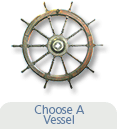
|
||||||||||||||||||||||||||||||||||||
OverviewThe C.A. Thayer was one of 123 three-masted schooners built on the WestCoast for the lumber trade. From 1895 until 1912 she sailed for the E.K. Wood Lumber Company of San Francisco. She was then purchased by “Whitehead Pete” Nelson, owner of a salmon salting station in Alaska. C.A. Thayer made yearly trips from San Francisco to Bristol Bay carrying men and supplies. In 1925 Thayer became a codfisherman, sailing from Poulsbo, Washington and fishing in the Bering Sea. Her final trip, in 1950, was the last commercial voyage by a West Coast Sailing vessel. Statistics: Built: 1895, Fairhaven, Humboldt Bay, California Builder: Hans D. Bendixsen Shipyard Dimensions: Length on deck – 156 feet. Beam – 36 feet. Gross Tonnage – 453. During the half century between the Civil War and the First World War, the Pacific Coast lumber trade became one of the world's great maritime industries. The cities and towns of the West were building, and the vast bulk of the lumber for their construction was shipped from Northern California and the Pacific Northwest aboard sailing vessels designed specifically for the trade. These were craft with great unobstructed holds and with the stability to carry half their lumber cargo on deck. Before the era ended, the shipyards of San Francisco Bay, Humboldt Bay, Coos Bay, Grays Harbor, and Puget Sound had launched some 80 barkentines, 300 three and four‑masted schooners, and upwards of 500 two-masted schooners. Of this great fleet, only the C.A. Thayer survives as a memorial to the departed days of Pacific Coast. The C.A. Thayer is a typical West Coast lumber schooner. In size, she is about halfway between the early two‑masted schooners that carried redwood lumber out of the Mendocino Coast and the larger five-masters lifting two million feet of lumber, which were built at the turn of the century. The Thayer was built by the well‑known Humboldt Bay Shipbuilder Hans D, Bendixen in 1895, and was the twenty-eighth three‑masted schooner to be launched from his ways. |
||||||||||||||||||||||||||||||||||||
C.A. Thayer’s Builder |
||||||||||||||||||||||||||||||||||||
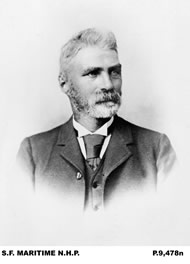 |
||||||||||||||||||||||||||||||||||||
| Hans Ditler Bendixsen, builder of the C.A.Thayer, master shipbuilder of Humboldt Bay, and designer of scores of sailing lumber carriers, is one of the notable figures in Pacific Coast maritime history. Between 1875 and 1901 he launched 50 three and four-masted schooners at his Fairhaven yard, and in his lifetime built some 115 vessels of all types. | ||||||||||||||||||||||||||||||||||||
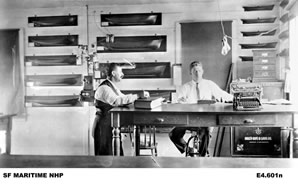 |
||||||||||||||||||||||||||||||||||||
Birthplace of the C.A. ThayerThe office of Hans Bendixsen was a working archive of lumber carrier models. The C.A. Thayer was built from one of these models seen on the wall, shaped by the knowledgeable hand and eye of one of the most prolific designers and shipbuilders on the Coast. Bendixsen built two-masted schooners for the Mendocino Coast, South Sea schooner and brigantines, steam schooners, and steamers, but he is best remembered for the three, four, and five-masted schooners and barkentines he built for the coastal lumber trade. Return to Top |
||||||||||||||||||||||||||||||||||||
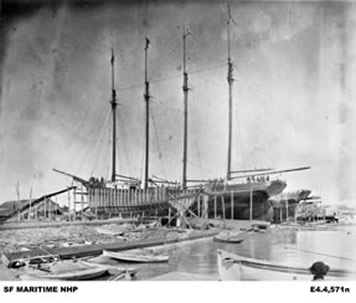 |
||||||||||||||||||||||||||||||||||||
C. A. Thayer as Lumber Schooner, 1895 - 1912Thayer’s owners, the E.K. Wood Company, had the her built to carry Douglas Fir lumber from their Hoqium, Washington mill to San Francisco. The Thayer, one of the first of E.K. Wood's fleet, was typical of the scores of lumber schooners that linked the forests and mills of the Northwest with the burgeoning and lumber‑hungry cities of San Francisco and Los Angeles. [Thayer loading at Hoquiam, F1.6,375] = No photo reference on CD yet |
||||||||||||||||||||||||||||||||||||
Sailing Day at HoquiamThe Thayer is fully loaded, her main deck nearly awash, as she waits for the tug to tow her out of Grays Harbor. The lumber that built San Francisco, Los Angeles, and San Diego came largely from the forests of Oregon and Washington. Between 1870 and 1905 ever larger schooners, built of this same Douglas fir, transported the billions of board feet consumed in California’s successive construction booms. Although the Thayer's port of registry was San Francisco, Hoquiam, site of the largest E. K. Wood mill, was her headquarters during her years as a lumber carrier. Here, on the shores of Grays Harbor, many of her officers and crew made their homes. The Thayer returned to Hoquiam some half‑dozen times a year to load another 575,000 board feet of lumber. |
||||||||||||||||||||||||||||||||||||
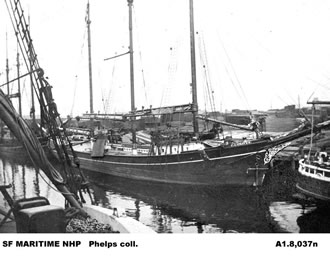 |
||||||||||||||||||||||||||||||||||||
Under Sail on San Francisco BayThe Sadie, a near‑sister of the C.A. Thayer, arrives at San Francisco with a deck‑load of lumber. West Coast schooners were designed to carry more than half of their cargo on deck, and the crew worked the vessel from atop the towering load. Note that the booms are raised to clear the load and the pinrails in the shrouds are high above the deck level. |
||||||||||||||||||||||||||||||||||||
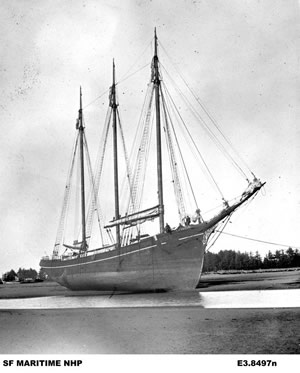 |
||||||||||||||||||||||||||||||||||||
Discharging at Channel StreetThe Thayer, lying near Third and Channel, San Francisco, has just discharged her cargo of Douglas fir. The year is 1905. The metropolitan lumber yards of E. K. Wood, Pope & Talbot and others served as distribution points in San Francisco and San Pedro. During the era of the sailing schooners these yards stocked huge quantities of lumber. |
||||||||||||||||||||||||||||||||||||
Stranded at Grays HarborThe career of the C.A. Thayer nearly ended on the morning of November 8, 1903 when gale‑whipped seas smashed her rudder and drove the helpless schooner up on the spit at the entrance to Grays Harbor. At nightfall the Life Saving Service brought her crew ashore in the breeches buoy, abandoning the vessel to what seemed certain destruction. But within a month Captain Monson got her afloat, and, behind a Grays Harbor tug, brought her safely across the bar and up the bay to Hoquiam. Return to Top |
||||||||||||||||||||||||||||||||||||
C.A. Thayer as a Salmon Packet, 1912 ‑ 1924 |
||||||||||||||||||||||||||||||||||||
|
The C.A. Thayer joined one of the last great sailing fleets of the world when she became an Alaska salmon packet. This fleet flew the house flags of a variety of companies, large and small. Dozens of sailing vessels‑which had been forced from world trade routes by the ubiquitous steamer found a new career sailing to Alaska from San Francisco, the Columbia River, and Puget Sound. These ships served as transports, or "packets" for men and supplies and in the fall they carried back the catch from the canneries and salteries. |
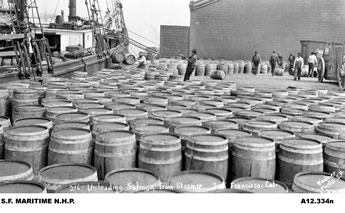 |
|||||||||||||||||||||||||||||||||||
Landing Pickled Salmon on the San Francisco WaterfrontThe schooner unloading barrels of Alaska salt salmon at China Basin is the four-master Salvator, chartered by Peter Nelson for the 1906 season, six years before he bought the three‑master C.A. Thayer. Before 1900, most Alaska salmon packers, including even the giant Alaska Packers Association, had chartered rather than owned the vessels they needed for the season, but as the prices of old ships, barks, and schooners declined under the impact of steamship competition it became more attractive to buy ships outright. |
||||||||||||||||||||||||||||||||||||
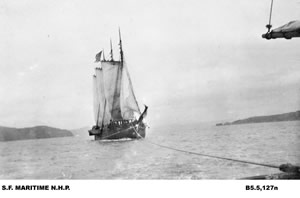 |
||||||||||||||||||||||||||||||||||||
San Francisco’s “Salt Salmon King”“Whitehead Pete" Nelson, operator of Alaska's leading salmon salteries, bought the C.A. Thayer from the E.K. Wood Lumber Company early in 1912. Each spring, through 1924, she carried men and supplies to Nelson’s salteries at Igushik and Squaw Creek on Bristol Bay, returning in the fall with the year's pack of salted salmon. |
||||||||||||||||||||||||||||||||||||
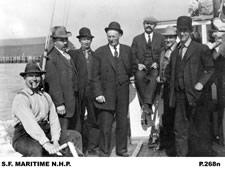 |
||||||||||||||||||||||||||||||||||||
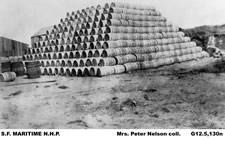 |
||||||||||||||||||||||||||||||||||||
|
Peter Nelson sailed as a fisherman to Bristol Bay before the turn of the century. An ambitious man, with a keen head for business, he soon established his own saltery. He prospered modestly, bought boats and ships, and built new salteries. A big man in a small trade, Pete Nelson was San Francisco's "Salt Salmon King." |
||||||||||||||||||||||||||||||||||||
Pickling SalmonIn the early days of the Alaska salmon fishery, salting stations which proved successful frequently were replaced with canneries. Pickled salmon, as opposed to the “mild cured” luxury product or the inferior dry salted salmon, was largely driven from the market by the spread of canning. During most of his career Peter Nelson, the “Salt Salmon King”, worked with this obsolete process and product. To pickle salmon, the split, cleaned fish, minus the head, was opened flat and laid in large pickling butts. The salter, usually Pete himself, worked around the top of the fish, sprinkling coarse salt over each layer of fish that was laid down in the tanks. The weight of the mass of fish pressed the water from their bodies, forming a strong brine solution. After the salmon had. pickled for about a week they were removed, scrubbed, and repacked in 200 pound barrels for transport to San Francisco and thence to the East Coast market. |
||||||||||||||||||||||||||||||||||||
The Nelson Salteries on Bristol BayPeter Nelson established his first saltery in 1902, on the winding Igushik River, not far from Nushagak Bay. The photo was taken from the end of the long pier that extended out over the tide flats from the station. The Squaw Creek or Kaggiong station, which was to become the mainstay of his operation, was “prospected” by Nelson in 1912. In the picture at the top Mrs. Hilda Nelson sits on the porch of the snug "White House" he built for the extensive Squaw Creek establishment. A third station, at Copenhagen Creek, was opened later. In 1925 the A & P Products Company, a subsidiary of the giant Eastern food chain, bought out Nelson in order to get the excellent Squaw Creek location as a, cannery site. They built their cannery and Peter Nelson retired from the saltery business with a handsome profit. Within a few years of its purchase in 1867, Alaska, called “Seward's Folly”, was paying handsome profits from its salmon streams. By 1912, when the C.A. Thayer made her first voyage to the muddy creeks opening off Bristol Bay, the Alaska salmon fishery was the most valuable in the world, and Bristol Bay salmon was a common item on dinner tables from England to New South Wales. |
||||||||||||||||||||||||||||||||||||
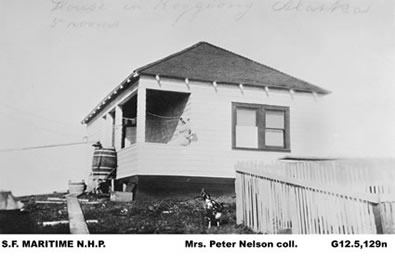 |
||||||||||||||||||||||||||||||||||||
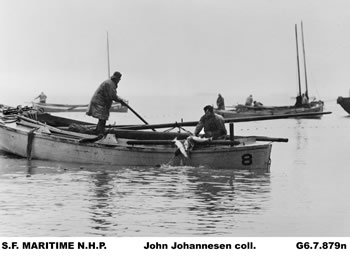 |
||||||||||||||||||||||||||||||||||||
Fishing Boats of Bristol BayThe boats used by the fishermen for gillnetting in the Nushagak and Kvichak Rivers were the seaworthy "Columbia River salmon boats." Peter Nelson ran sixteen of these handsome sail and oar- propelled craft in 1924, just before he sold out to the A & P Products Corporation. Designed for sailing as well as rowing, the Columbia River boat was a round bottomed, centerboard craft. When fishing, each boat carried a crew of two men, a fisherman and a boat‑puller. During the peak of the fishing season these men literally lived in their boats. When they were not fishing they spread the sail over the forward part of the boat to form a tent, heated cans of beans over a tiny kerosene burner, and sprawled on the floor‑boards for a few hours of sleep. Carl Johnson, shown here standing in one of Peter Nelson's boats, recalled: “You sleep anywhere you could make the best of it. In 1918 I fished for five days night and day. I don't know if I threw the fish in the boat or I threw them overboard. Five days I didn't sleep at all. Then Pete went on the 3,000 limit. He said, ‘You fellows will either drown yourselves, or kill yourselves, so a 3,000, limit we will go on!'” |
||||||||||||||||||||||||||||||||||||
C.A.Thayer as Codfish Schooner, 1925‑1950Twenty-five Years a CodfishermanWhen Peter Nelson sold his Alaska salteries, J. E. Shields was on the lookout for a bargain‑priced schooner for his Pacific Coast Cod Fishing Company. He snapped up the vessel where she lay in the Oakland Estuary. Shields loaded the C.A. Thayer with salt, and she sailed for her new home port of Seattle. Shields fitted up a large fo’cs’le at the forward end of the hold to a accommodate thirty or more fishermen on a five‑month cruise. On deck were nests of cod fishermen's dories. The Thayer sailed from Seattle for the Bering Sea on April 26, under the command of Captain John Grotle. She returned from this first of her twelve cod fishing expeditions on September 18, with 256,000 fish, the largest catch in the Northwest schooner fleet. In 1931, at the end of her seventh codfishing voyage, Captain Grotle brought the Thayer back with a record catch of 302,000 fish. The success of this season induced J. E. Shields to replace the Thayer with an even larger schooner, the four‑masted Sophie Christenson. The Thayer was decommissioned, to lie idle in Lake Union, at Seattle, for a decade. The U.S. Army requisitioned the laid‑up schooner in 1942, removed her masts, repaired her hull, converted her into a floating storehouse for empty shell‑cases, and towed her to Prince Rupert, B. C. After the war Captain Shields re‑purchased the Thayer from the Army, refitted her, and sent her cod fishing to the Bering Sea for five more years. When the C.A. Thayer returned from her last voyage north in 1950, commanded by J. E. Shields’ son Ed, she was the last sailing vessel in active commercial use on the Pacific Coast, and a lonely anachronism in an unprofitable industry. |
||||||||||||||||||||||||||||||||||||
Deck of a CodfishermanThe C.A. Thayer (at left) tows up the Puget Sound to Poulsbo at the end of the 1948 fishing season. The outboard motor powered dories, fitted with canvass sprayhoods over the bows, were a great improvement over the oar‑and‑sail propelled craft which they replaced. But despite this "modernization", the methods of the fishery and the life of the fisherman were much the same in 1948 as in 1878." The submarine banks favored by the Pacific codfish lie about the Aleutian Islands and in the storm‑swept Bering Sea ‑ 1800 miles from Puget Sound. Twelve times between 1925 and 1950 the C.A. Thayer voyaged to this last haunt of the West Coast schooner.[Need image of Bering Sea chart] |
||||||||||||||||||||||||||||||||||||
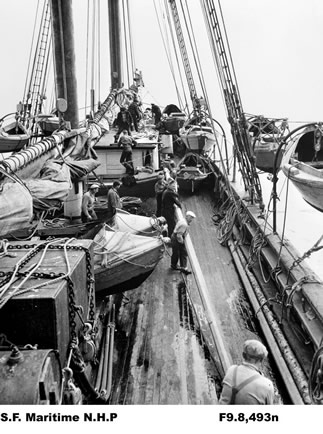 |
||||||||||||||||||||||||||||||||||||
The Codfish BanksOn this chart the major codfishing banks of Western Alaska are outlined in brown. The codfishing schooners sailing out of San Francisco and Puget Sound usually worked the small banks south of the Unimak Pass to Slime Bank in early summer, and on to Baird Bank later in the season. “Nobody Wants Salt Cod” The Decline of the Codfish Industry Salt codfish, the age-old staple of Northern Europe's maritime peoples, declined rapidly in popularity with the food processing revolution of our times. This photograph shows Archie Shields salting down cod in the hold of the C.A. Thayer in 1953, the method of preserving freshly caught fish that had been used for centuries. As these fish were removed from the Thayer’s hold to the great brine tanks on The Pacific Coast Codfish Company dock for ultimate processing and packaging, the realization grew that this scene would not be repeated another year. Nor would the codfishing schooners ever again come alive in the busy outfitting of April, more over to the Seattle wharves to load hundreds of tons of salt, ship their hardy crews aboard, and tow out through the Straits of Juan de Fuca, bound for a six month cruise to the Bering Sea. |
||||||||||||||||||||||||||||||||||||
